Back in the coach, we were shown around the surface of the mine, being given an informative and often humorous commentary by the coach driver. Hardly a sentence would go by where he didn’t refer to some aspect of the mine, or the equipment used, as “the biggest in the world.”
After the tour we shopped at Kmart and Coles, before returning to the van for lunch. After lunch I took off for the local Holden dealer where the car was to have the wheel alignment checked and the tyres rotated. As this was being done I collected RACQ maps of Queensland, organised mail, buying oil change stuff, hats, birthday presents and books etc.. The lady at the book exchange was busy writing out her family tree. She talked to me as I could help her with some information about the Salvation Army’s home in Collaroy and its nursing homes on Collaroy Plateau.
The day had been warm, but not hot by Northern Territory standards, so a swim was in order. The pool was deliciously cool; or if you asked Jacqui and Rohan it was cold. Consequently, our swim was remarkably short.
Back at the caravan park, the car got a thorough and much needed clean, but it still stinks inside. While I was doing this, I noticed one of the tyres was going flat. After locating the leak in the campground’s laundry tub, I decided to try to repair the leak myself. Unfortunately, the tube of glue with the repair kit was empty. In any case I suspect the damage may be terminal. We’ll see in the morning.
A huge coach, towing a trailer, arrived during my car clean-out. Duane Woodcock, an ex-student of Ian’s from Barrenjoey High School in 1986, emerged from the coach. He had been on a 20-day fishing Safari to Kakadu. He had been in the bus for 36 hours on his return journey to get to Mt Isa. And he would be on it again for a further 48 hours before arriving home in Sydney next Monday. That is not my idea of fun, but he had caught some good-sized fish in Yellow Waters.
For dinner we tucked into a baked dinner. As usual it was yummy!
Saturday, 19 May 1990
Shopping around for a new tyre, as the damage to the one I was working on yesterday was terminal, I got some interesting responses: we don’t stock Goodyear tyres; I can get one in and it will cost $125; yes we have one in stock for $95. So, after refuelling and getting the new tyre, we were on our way east.
The road from Mount Isa to Cloncurry passes through rugged hills, twisting and turning as it goes. Spinifex sparsely covered these hills and I thought often of the prospector who first found the Mt Isa ore body. I thought of him (it may have been a woman!) tramping over the mountains in the middle of summer, hundreds of kilometres from the nearest town, looking at each and every rock. Prospectors are, to my way of thinking, and incredibly courageous breed.
At Cloncurry we stopped for lunch and fell into conversation with Lee and his wife. Lee was a former dentist from Coffs Harbour, who had two months ago sold his practice and was at the beginning of a two-year trip around the country with his two boys who were aged one and three years. We spoke of all the usual things including places to see etc,. We found out that he went to school with Alan Orr, who is the brother of our close friend, Helen Oberg. Lee had played cards with Alan when they were schoolboys and he said that Alan was always a gambler, even at school.
Eastwards from Cloncurry, the land was monotonously flat and almost bare of trees. Although relatively brown, there seems to be reasonable feed for the cattle.
At Julia Creek we found one milk bar closed until 5 PM (it was 3:30 PM) and, at another, we were told by the owner that he too would be closed until 5 PM. Finally, we were able to get ice creams at the local Roadhouse. Julia Creek was not mourned as we left.
For hours, the country rolled by, but it began to change. By the time we reached Richmond, for as far as the eye could see, there was green grass. Really green! Obviously, the recent rains had left their mark and some of the creeks were actually full of water! Also, at Richmond, we were given what we hope will be good advice about fuel and road conditions by the lady who ran the petrol station.
Our intended campsite this night was a roadside stop just outside of Hughenden. However, it was chained off and a large “no camping” sign warned us off. Consequently, we stayed in a Hughenden caravan park that is 100 m from the railway shunting yards. All night the sound of continuous shunting of cattle trucks could be heard. The most disturbing aspect of this was the smell carried on a cool South easterly wind.
Tomorrow the coast!
Sunday 20th of May 1990
What a shock to the system, I actually needed to put a sloppy joe on this morning. In reality it wasn’t cold but comparatively…..
On the road by 8:30 AM with a long stretch of 200 km to Charters Towers. We stopped at an excellent roadside stop called the Campaspe River rest stop, where I change the oil and oil filter. [2020 note: I recall doing this by digging a hole in the sandy ground and draining the used engine oil into that. I feel embarrassed to have to admit to doing that!] Fuel at Woodstock was only 61.9 cents per litre. We stopped there after lunching in the “charming” old town of Charters Towers where the shops in the main street were impressive - freshly painted with authentic stained glass windows.
On the coast, humidity was high, but the much lower temperature made it feel pleasant compared with Darwin and Kakadu.
Sunday is a good day to arrive in a new town, especially a big one like Townsville where we were able to drive through the CBD , park and work out where to go next, without difficulty or the pressure of “active” parking meters.
On the way to the caravan park we had chosen, we passed a few superbly restored shops that had intricate woodwork and cast-iron railings, around deep verandas. All the shops glistened in the bright tropical sunlight. At the caravan park, we phoned home and swam in their pool, before getting an early night. By the way, even though we are near mangroves, there are few mozzies.
Monday, 21 May 1990 Jacqui’s birthday.
The day started as it was to remain, overcast and warm, threatening rain but never getting around to it.
Having washed we needed to wait until it was dry, before heading off for a day of sightseeing and touristy things.
We visited the post office, climbed to the top of Castle Hill for an overview of the town and hinterland. Townsville is large, stretching off into a suburban haze, to the west and south-west, while the eastern portion is bounded by the sea and is primarily industrial, related to the port or tourist-oriented hotels and parks et cetera.
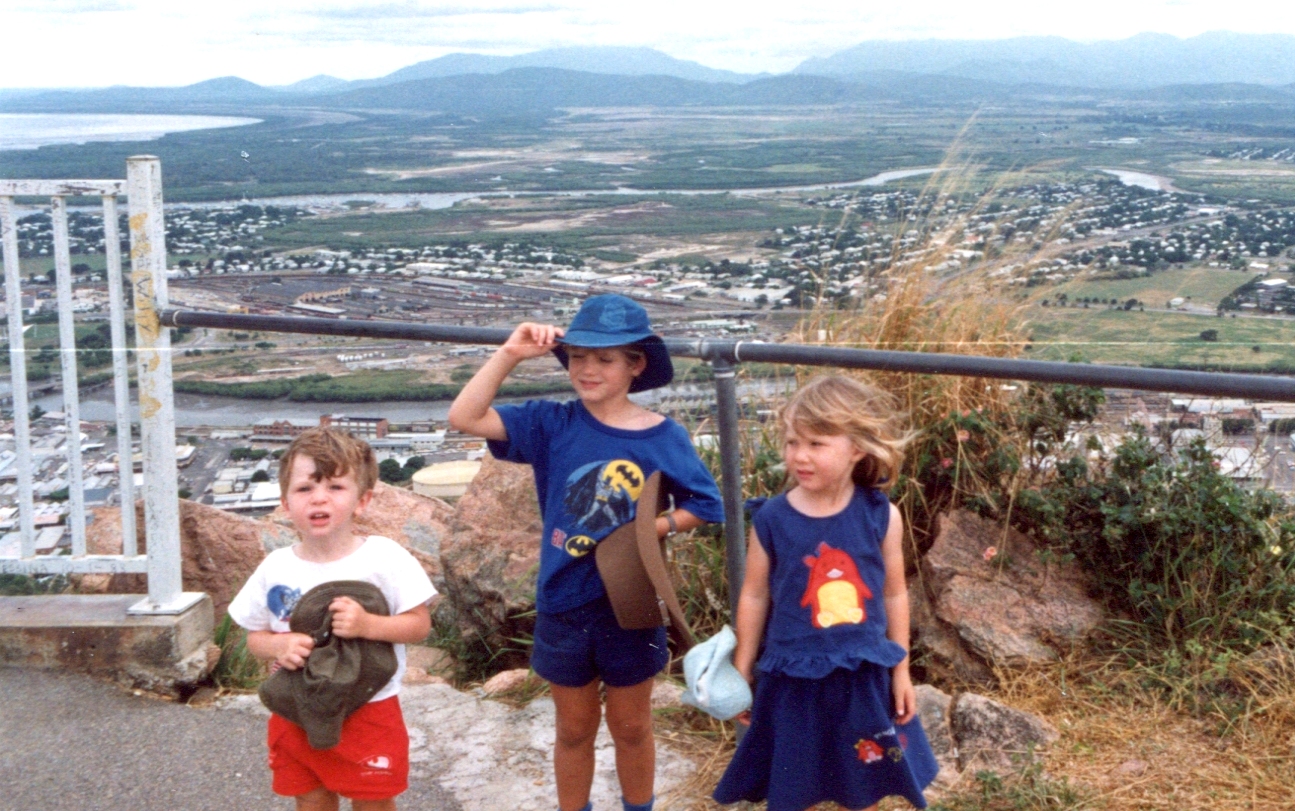
From there, we went to the Pizza Hut for lunch, and spent some time in an Asian supermarket, where Jacqui purchased special spices and ingredients. We also drove around like a chook without its head, looking for a seafood shop. With the aid of the CB radio, and a good deal of luck, we found one. We bought prawns for $12 per kilo and calamari for $6.50 per kilo.
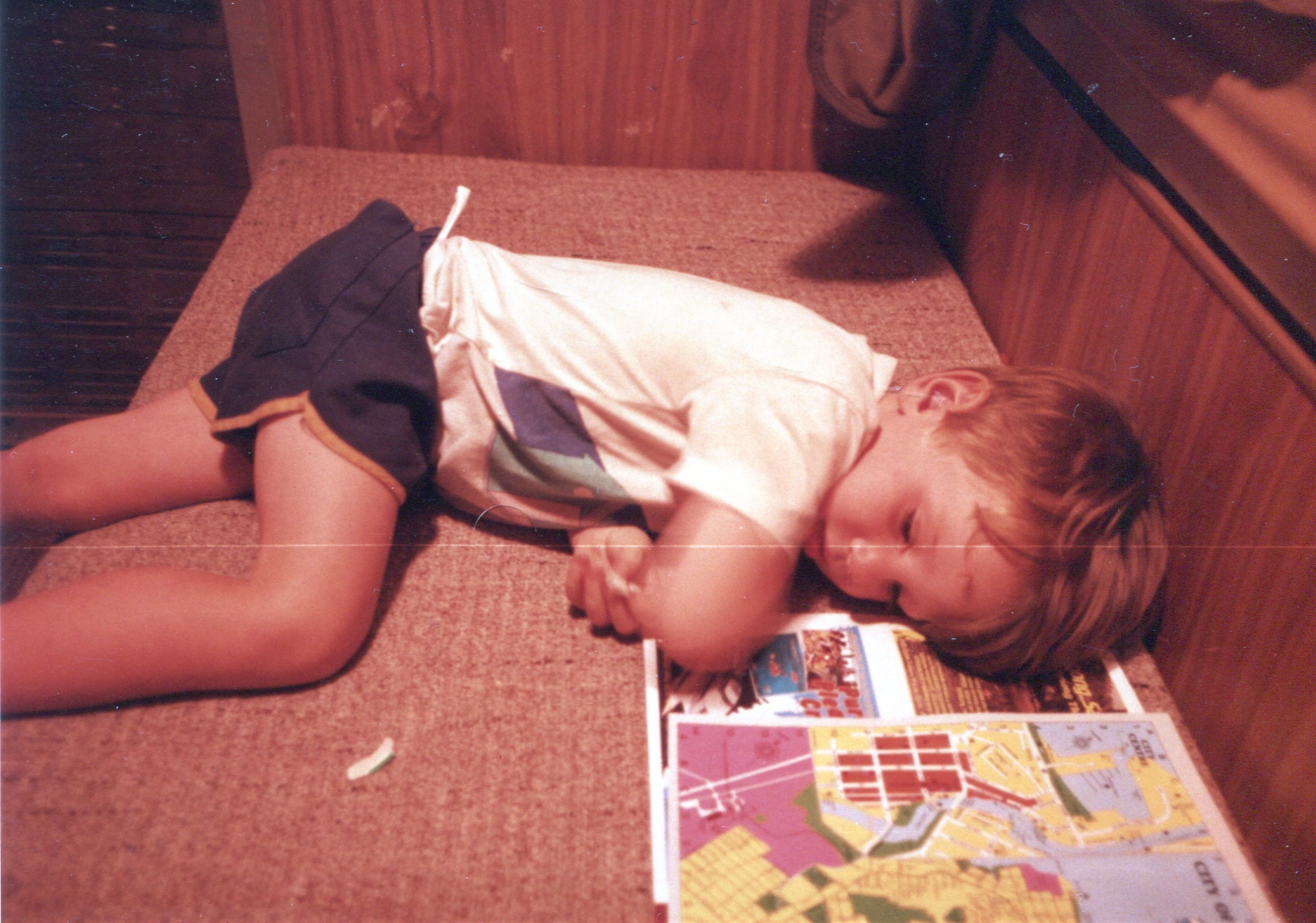
Rohan
After depositing the perishable items in the fridge back at the van, we again drove to the city where we parked, and walked to the Great Barrier Reef wonderland centre. After parting with $45 for aquarium, OmniMax theatre and museum tickets, we started our tour of the aquarium.
Well-presented displays, excellent photographs with informative written sections were present and to be expected. The highlight, however, was the huge saltwater tank, with simulated reef and a wave machine. Brightly coloured fish, coral of many different types and sea slugs as big as a man’s arm, were all to be seen. Smaller tanks had exhibitions with particular themes including stone fish and rainbow coral (poisonous), seahorses, crustaceans, sea snakes, moray eels, clownfish and anemones and soft corals. The part which made the greatest impression was the semicircular glass tunnel, through which we walked viewing the residents of the reef tank and predator tank at close quarters. Sharks and rays, cod and other sleek predators, glided effortlessly past our noses. It was great, Rohan even spent a few minutes eye to eye with what looked like a spotted barramundi. We also saw a display of shark jaws with teeth. Mako sharks have teeth like wobbegongs with lots of incredibly sharp small teeth. I’ll treat wobbegongs with more respect when I dive. Lachlan’s head could fit in a shark’s jaw which was big enough to bite his head off. Its teeth were three directional. See below:
I now see why large sharks, such as bronze whalers which can grow up to 2.92 m can be called man eaters
At 3:30 PM, we all received a stamp on the wrist and filed past the Omnimax projector, for a theatre with reclining seats below a hemispherical dome. Huge speakers were revealed when the lights were dimmed in the house and turned on behind the screen.
The program on the reef had some stomach-turning moments, usually footage taken from helicopters, but in general it was a little sensationalised. Given that Ron and Valerie Taylor were involved, I suppose only 1 to 2 minutes of shark footage, where we saw bronze whalers ripped to shreds another shark, was quite subdued
The kids found some of it disturbing, although more because of the sensations, rather than images
The old bloke next to me went to sleep.
We were again in the aquarium from 4.30 PM until 5 PM, we saw, well the kids did, a sea snake shedding its skin.
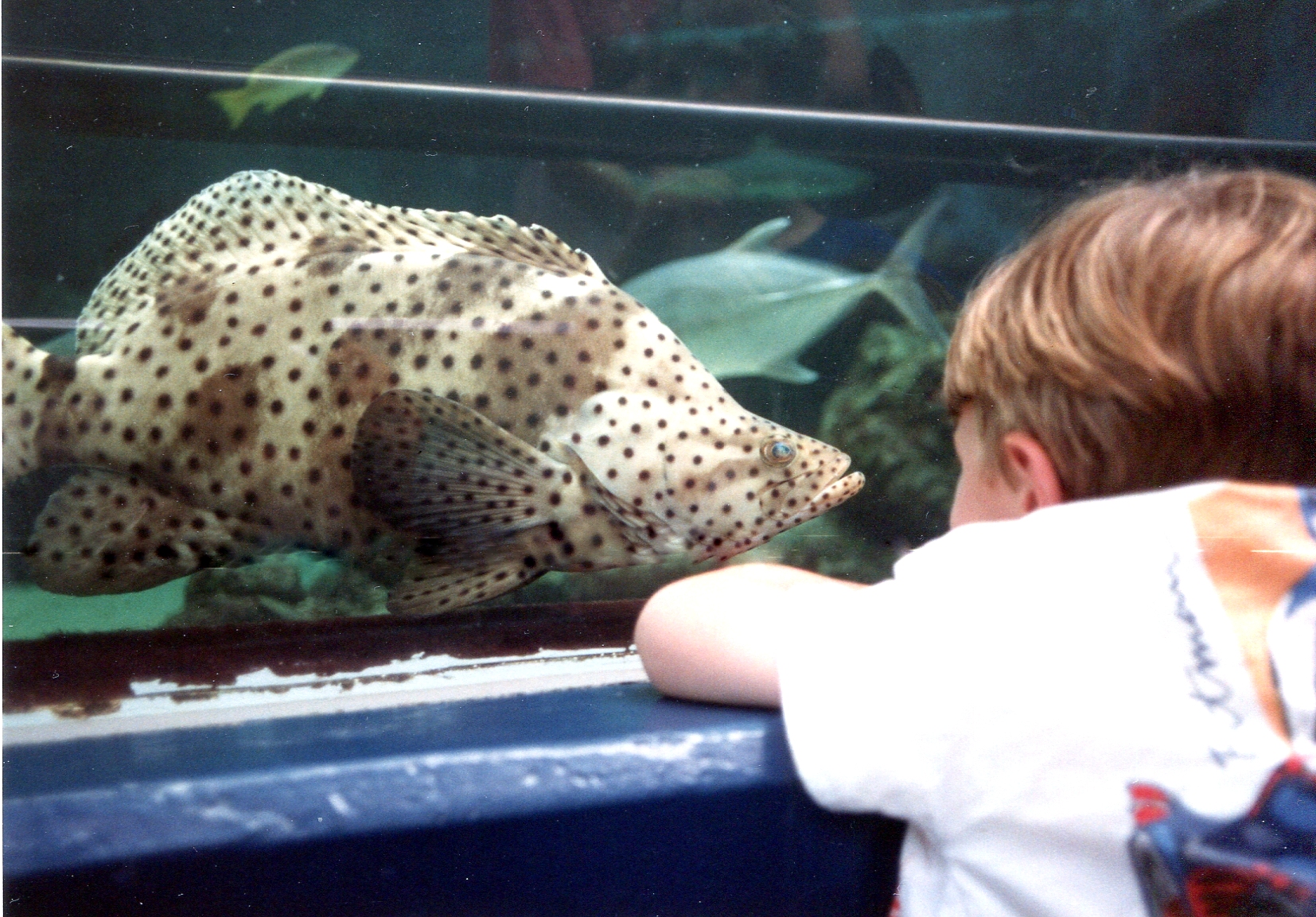
Rohan and friend at the Townsville Aquarium
Back at the van, the kids had a swim and Lachlan swam the length of the pool without assistance. Jacqui, since it was her birthdaty, cooked a tasty prawn soup, and for dessert we tucked into a cheesecake to celebrate. A bottle of Oberge, which seems to be getting better all the time, was nice .
In the aquarium there was a display of shark jaws including their teeth. Mako sharks have teeth like wobbegones. The Mako sharks jaw had lots of incredibly sharp small teeth. I’ll treat wobbegones with more respect when I dive. Laughlan put a sharks jaw around his head. It was big enough to bite around his whole head and had three directional teeth. I can now see why large sharks such as bronze whalers, which can grow up to 2.9 m maximum, are called man eaters.
Tuesday, 22 May 1990
During the night and for most of the following morning we were treated to frequent, torrential downpours. At one time Jacqui and I were cornered in 2 to 3 m² of dry space under the annex. At around 10:30 AM, we packed some lunch and headed back to the Great Barrier Reef wonderland. We looked at the Queensland Museum displays even though the display was housed in only one largish room they had a good range of displays from wildlife of Townsville, common moths snakes and apples of northern Queensland to aboriginal artefacts, ship wreck recollections and jigsaw puzzles. The latter was by far the most popular amongst the troops, being of a extinct dinosaur, made from craft wood and about 30 cm² .
After munching on some doughnuts and browsing in the shops of the Great Barrier Wonderland, we headed back to the van for lunch.
After a suitable interval, that is until the kids were climbing the walls, we went to target for Transformers and woollies for groceries. Then back to the van, more heavy showers, more wall climbing and an early night for the kids. Jackie and I sat up and huddled against the rain until late.
Wednesday, 23 May 1990
More rain during the morning, so we decide to stay put, which is just what we did. Jacqui washing and electrically drying. The kids colouring in and I read.
After lunch there was a break in the weather so we took the opportunity to use the pool at the caravan park. At the time of writing, there is a breeze which feels drier, drier than it has been, although there is still a heavy cloud cover.
Thursday, 24 May 1990
It was cool this morning, in fact to our tropical air-conditioned bodies, it was cold. We all put on our jumpers et cetera. As the day progressed, didn’t warm significantly and after lunch we heard that the temperature in Townsville reached a fraction of a degree over 20°C.
Jacqui spent nearly the whole day reorganising the junk in the van, whilst I went to the local wrecker to fix the high beams which period fortunately I was able to try the switch before buying, as the problem remained, even with the new switch. I still don’t know where the problem lies, even after checking out the wiring diagram for an hour or so. I did manage to buy a relay for around five dollars but I thought this was expensive so I said so and eventually got it for two dollars.
Throughout the remainder of the day I read the kids played in Fort in the cool overcast. An army Black Hawk helicopter did circuits, turning over the park for a few hours during the late afternoon.
Friday 25th of May 1990
More rain and cold enough to have the heater going inside the van for most of the day before lunch we shopped, Jacqui buying a new pair of pants.
After lunch we drove south to Bowling Green National Park and to the Australian Institute for Maritime studies, which has its buildings in the park.
On the road to the park, which turns off the east from Highway one about 30 km south of Townsville, we saw lots of wildlife on the way to AIMS along the flat Road in swampy ground was a jabiru, egrets and wallabies.
After looking at numerous displays, in the Macquarie Uni like buildings, which included a coral drill and a record of outflow from the Burdekin River, based on a coral call, we saw more wallabies on the lawn around the late model Ford filled car parks. All of the cars had roo bars! They were all Commonwealth government cars. The road back was just as full of wildlife, only this time we sought to broker stalks and we were lucky enough to see one dancing. Unfortunately the battery was flat on the video camera.
Saturday, 26 May 1990
15°C minimum and a maximum of only 19°C, with rain nearly all day! Sydney had the same maximum, but at least it was fine!
During the morning we all went into town to buy a newspaper, visit a book exchange and get money.
The weather remained bad and we stayed inside, kids being as good as the conditions would allow.
Later in the afternoon we drove north along the flat Bay near magnetic island.
Back at the van, after dinner, everyone’s tempers were fraying-not surprising after a day cooped up!
Sunday 27th of May 1990
Overcast, cool and windy, but at least it wasn’t raining as we packed up to begin our trip to Cairns.
Shortly before reaching tally, the sugarcane fields began. These were covering the flat areas between rugged mountain ranges and truly rugged they are, protruding abruptly and steeply well into the clouds, frequently into obvious heavy rain. Tully and Innisfail both lived up to their reputations as the wettest places in Australia, although we were only sprinkled upon as we drove through.
As well as sugarcane we saw fields of pineapples and bananas. The kids thought the tramways used to transport the harvested cane were interesting and I look forward to taking them on a tour of the sugar mill.
Our chosen campsite is at Ellis Beach, about 20 km north of Cairns. This gives us these of access to Cairns of which we saw mainly used car yards today and Mossman where we intend to visit the Daintree.
As I write I can hear waves breaking on the beach and occasional wind gusts that are blowing the chairs over. For a trip to the reef, such weather leaves a lot to be desired. I think will visit the Daintree first!
Monday, 28 May 1990
Still windy, but mild with a few holes in the clouds to let sunshine pass. Sitting on Ellis beach with the kids at around 8:30 AM, I had to get hats and was hot for the first time in a week.
Our trip today was to Port Douglas, Mossman, Cape tribulation and Daintree. The road snakes along, tenuously at the triple point - or where the sky, sea and land meet. Tenuously because generally the road has been made on steep hillsides, to call them cliffs would be a slight exaggeration but only slight, and the rain forest covered mountains rose steeply and unrelentingly until some actually punctured the not-so- low clouds.
After about 20 minutes we stopped at Rex’s lookout, from where we could see the coastline stretching south, towards Cairns, and to the north where rain and mist shrouded mountains gradually faded from view.
Sugarcane was planted on every square centimetre of relatively level ground, which began to appear 20 km south of Mossman. Here also was the turn-off for Port Douglas. Deciding we couldn’t go past Port Douglas, we turned in and spent a few hours looking around, fishing and eating. We fished from the jetty next to a 40-50’ game fishing-pleasure boat called Freedom. The thing which struck me about this gleaming fibreglass monster, was the retractable shower hose in the stern above the marlin board, obviously for snorkellers to shower before coming on board.
As usual, Anja caught the only fish, a 10 cm flounder, by using her technique of throwing in her line in and then going off and doing something else, which in this case was collecting shells from a nearby sandy beach.
From the wharf which jutted into the estuary, we could see the Mirage Marina and one of the quicksilver wave-piercing catamarans which wasn’t working today, probably due to the water being an opaque brown.
The Mirage Resort looks just as it does in the ads we are bombarded with on TV [2021 note: in the late 1980s the Mirage Resort was publicised widely and the owner Christopher Skase went on to become a well-known criminal being arrested when he attempted to flee to Spain Throughout the 1990s, successive Australian governments, in combination with Max Donnelly, attempted to have Skase extradited from Spain, with no success. Skase claimed that he was unable to travel due to a life-threatening lung condition. This was disputed by the Australian government, who released a video filmed by some Australian tourists, which featured Skase walking easily on a local beach. During this period, Skase also attempted to build a new business empire, and continued to live in a multimillion-dollar mansion. In one incident, television personality Andrew Denton organised a public subscription to hire a bounty hunter to kidnap Skase. However, after raising $250,000 the idea was called off on legal advice (source Wikipedia).].
Port Douglas is an odd mixture of old and new. The old snuggling almost unobtrusively next to smaller, flash resorts, which have developed piggybacking on the Mirages popularity.
From Port Douglas we drove through the rural town of Mossman to the Daintree River which we crossed on a commercial ferry. The river is about the same size and colour as the Hawkesbury at Wiseman’s Ferry, except it has saltwater crocodiles!
Once off the ferry we were on the Cape tribulation Road which is dirt, narrow, winding, muddy and rough. We travelled for one hour and covered about 20Km. In places the scar still remains vivid where the mountainside has been hacked away to produce this road. Rainforest teeters on the brink of cuttings with roots exposed clawing in mid-air [2021 note: the construction of this road through the Daintree rainforest was very contentious with Joe Bjelke-Peterson, the redneck Premier of Queensland, pushing the road through, even though its damage was permanent and unrepairable in human lifetimes].
We stopped on a beach where the kids played in the sand. They enjoyed making a channel and dams to divert the flow of a small freshwater creek which flowed into the sea.
Both on the way and on the way back we saw lots of buses on the road. They were mostly smallish coaster types, but one or two were large and four-wheel-drive coaches. It finally dawned on me why the road was so bad: these monsters travelling on it every day do a lot of damage!
The other thing that struck us was the number of private houses, farms, shops and pubs along the way. The Cape Tribulation National Park must have very ragged borders to accommodate all these private properties.
After re-crossing the Daintree river on the ferry, we could not not go to Daintree so we did. A small village with a few shops, gave us a chance to have afternoon tea and find out that a reef trip would be a waste of time as the waters were too muddy.
As I write, back at our Ellis Beach campsite, the winds feel strong, so there appears to be little chance of things settling down for a few days yet. After dinner, and for the second time, I have opened one of the numerous coconuts the kids had found. They drink the milk, and we eat the flesh. Lachlan informed us coconuts were in fact the seeds of coconut palms. How did he know - he had seen one growing near a van where it had been used, along with others, to make a wall.
Tuesday, 29 May 1990
Heading back towards Cairns from Ellis Beach, we turned right and followed Highway one as it wound its laborious way up to the Atherton tableland. The view from on top of the Great Dividing Range of Cairns and its hinterland, including Green Island, was spectacular. Also, it was significantly cooler than down below.
We paused only briefly at Kuranda, time to view the Barron River as it plunges spectacularly over the Barron Falls. At the same lookout we got a glimpse of the famous (and expensive) Kuranda railway. Kuranda itself was a nice little town, obviously given over entirely to pleasing tourists. Judging by the plethora of shops selling opals and the fact that the street was full of Japanese tourists, we decided to escape with our money intact.
At Mareeba we purchased bread at a drive-through bakery. My feelings on drive-through bakeries are that they won’t take off. Let’s face it, half the fun of going to a bakery, instead of a supermarket or drive through, is that you get to smell the wares before you buy. Sitting in our car, though, all you get are “interesting” odours of five months of habitation by 5 people.
We soon found the Centenary Park, which had all sorts of Miracle playground equipment that we had never seen before. The kids’ favourite is illustrated below
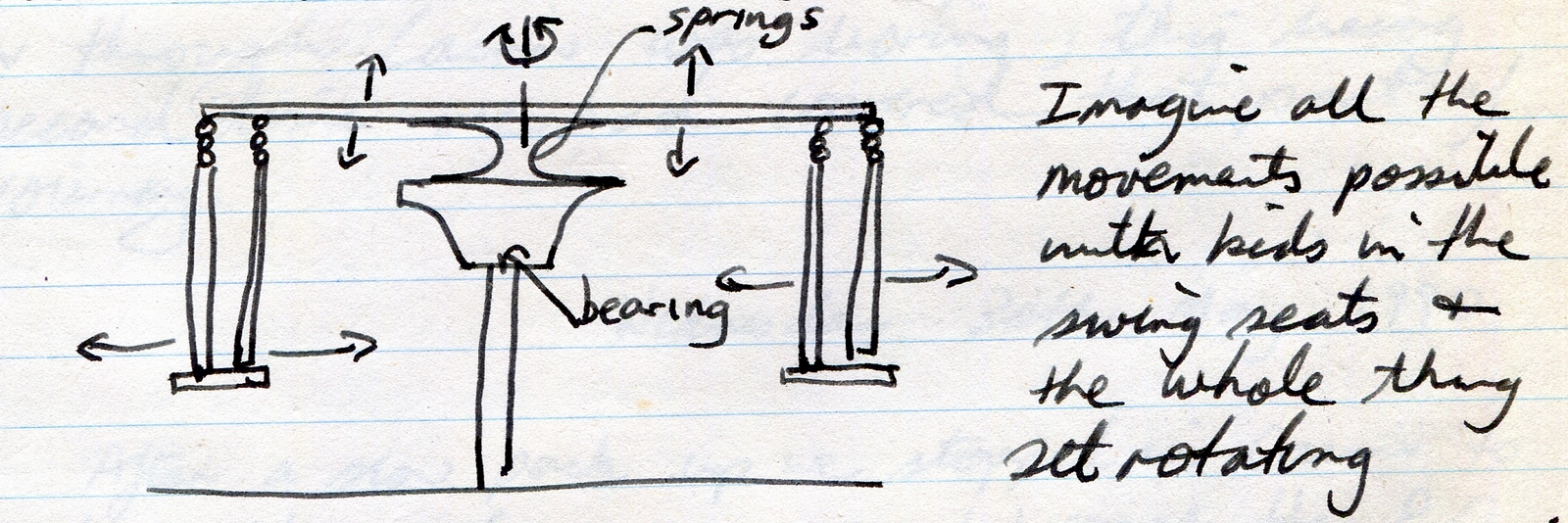
The only problem with this piece of equipment, from my point of view, is that it took a constant energy source to drive it - me!
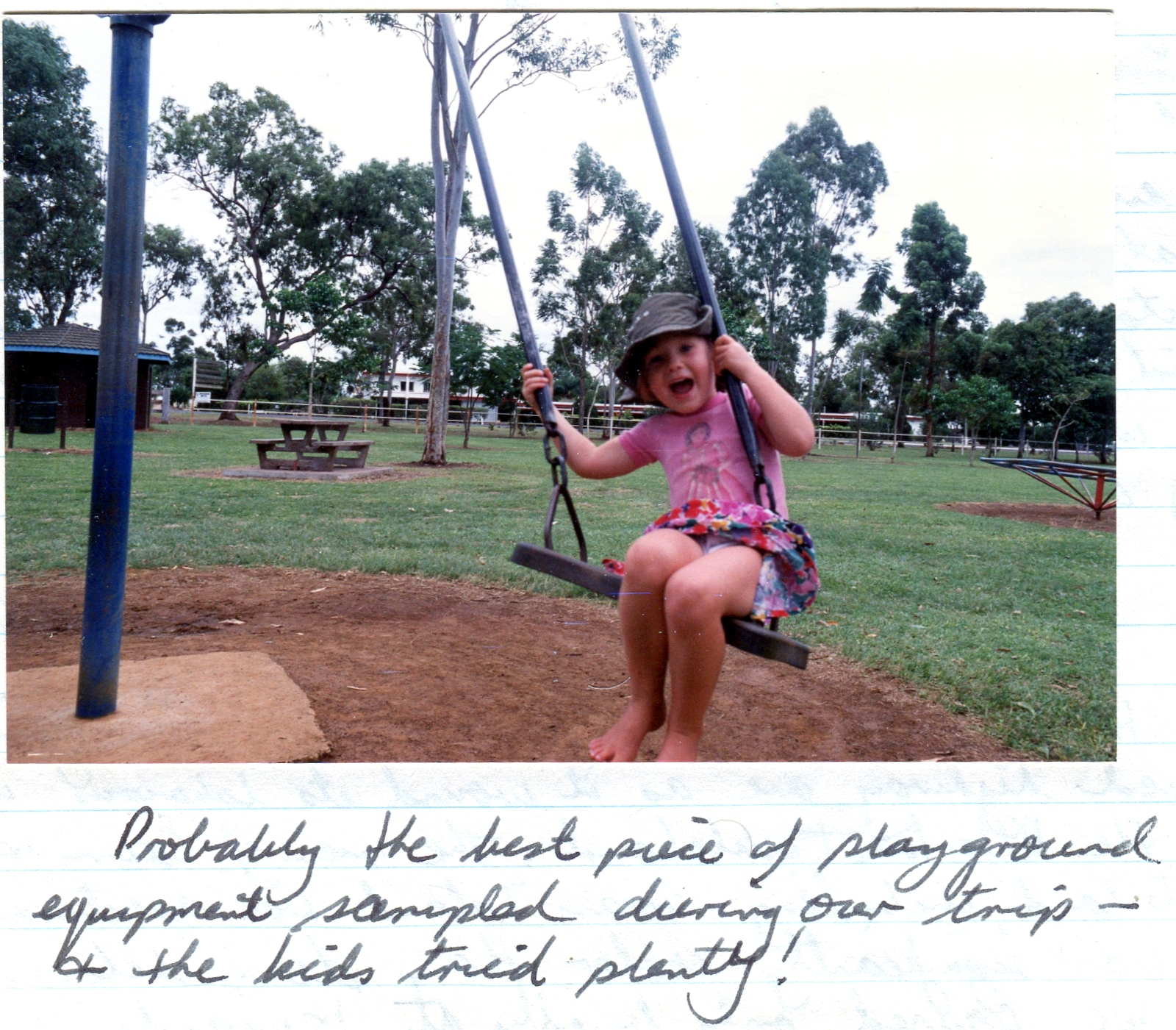
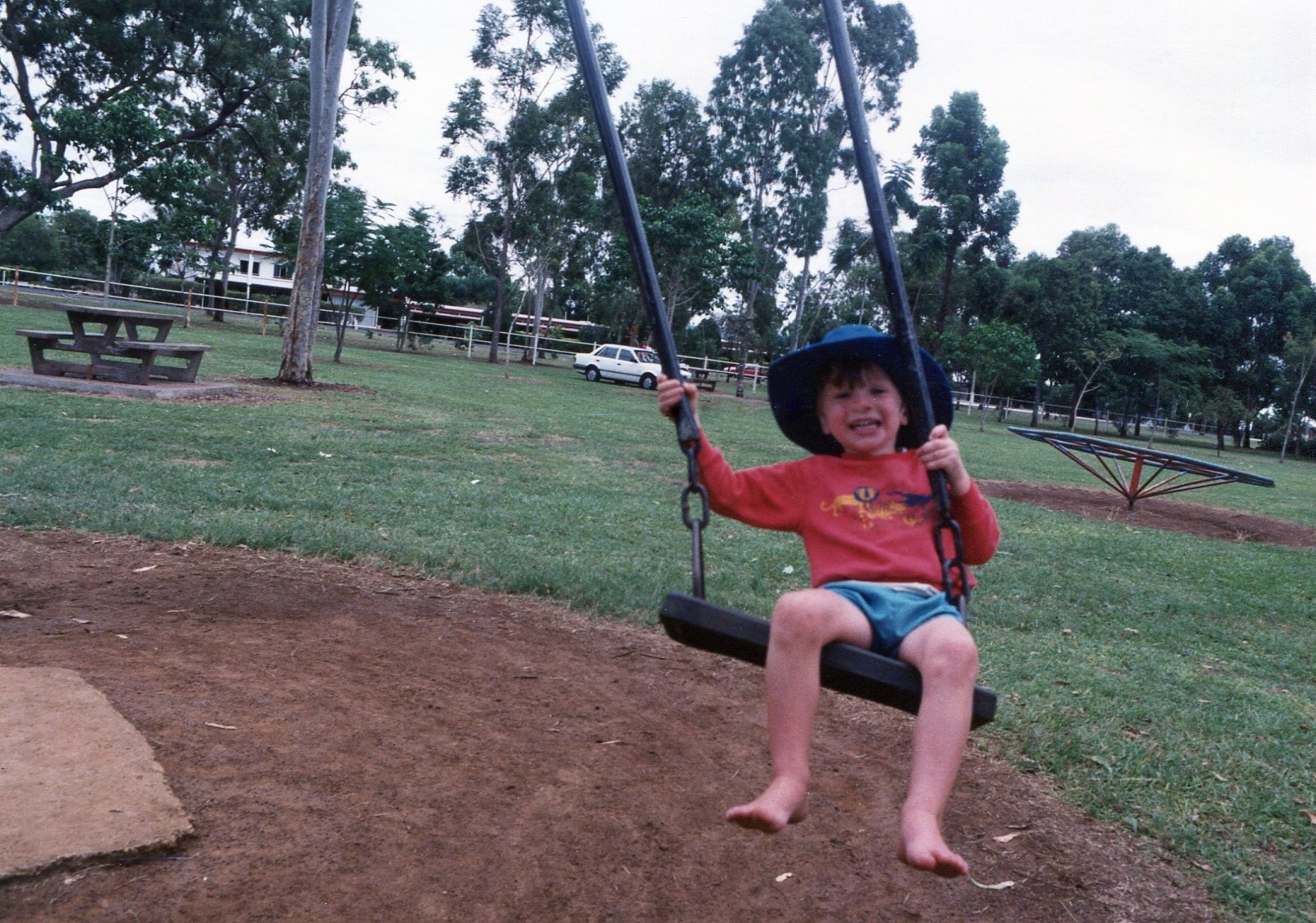
From there, as it was only 12:30 PM and we had already eaten fruit buns, we drove to Late Tinaroo for lunch. Lake Tinaroo is a large manmade lake, with excellent foreshore facilities and it turned out to be an ideal lunch stop. After lunch the kids played in the coarse sand on the water’s edge, while Jacqui and I read or admired the kids’ sandcastles. It was cold, and after giving Jacqui my sloppy Joe (she still has it on as I write late that evening) I was forced to don my Bellstaff motorcycle jacket.
The country around to Tinaroo was what we had expected to see on the Atherton tableland – flat agricultural land, covered in luscious green grass growing in rich red volcanic soil. Nowhere else on the trip have I seen so many cattle lying down.
Along the Gillies Highway we soon encountered lush rainforest and began our trip down to Cairns that was just as torturous as the trip up had been. Strangely the rainforest stopped abruptly about halfway down, giving way to open woodland with gums and casuarinas even though the only change was our elevation.
From Gordonvale, the trip back to Ellis Beach through Cairns was boring, this being the second time we have covered this part of our journey.
Wednesday, 30 May 1990
After a slow pack up, from our beachside camp at Ellis Beach we stopped in Cairns to check for mail and get some money (the Post Office had moved and I had to walk three blocks, while Jacqui remained in the car with the kids).
From there it was South to Innisfail for lunch and more mail collecting. Nextl stop was the Sugar Museum south of Innisfail at Mourilyan. This was okay (read bland) and we would have preferred to inspect a sugar mill in operation, but the harvesting doesn’t begin until June
At Mission Beach, we didn’t go to the Hideaway caravan park, but opted for the council run park over the road and directly on the Beach at half the price.
Thursday, 31 May 1990
Washing dominated the morning, not only did we need to wash all our clothes as usual, but the car seat covers needed a wash-especially as Anja had wet hers, albeit under extreme provocation from Lachlan who was tickling her at the time.
After lunch we packed off to South Mission Beach where we paid $30 to travel by water taxi to Dunk Island. The boat was an aluminium shark cat pushed along by two 115 hp Mercury outboard motors. Also on board were another family and two American backpackers.
After the short, relatively smooth ride across the narrow (3 to 4 km) stretch of water, the cat backed into the beach on Dunk Island passing about 20 moored yachts, next to a largish jetty.
Little hint of the Dunk Island resort [2021 note: This resort was devastated by a cyclone in 2011 and has remained closed ever since] could be seen from the water, which is as it should be!
Walking past two shops and a runway, we then moved onto the beach where the kids found numerous pieces of dead and broken coral. Before long all of them were carrying almost more than they had strength for. The accommodation and catering sections of the resort were hidden behind palm trees here.
At the end of the short beach, we entered the rainforest, walking in the gloom and silence of this world. The tranquillity was broken only by Rohan’s continual noisy complaints about having been made to walk so far. The walk was 560m, ending at Muggy Muggy Bay that had a 20 m long beach, bounded at each end by vertically dipping dark grey schist outcrops, which struck roughly north-south, forming effective barriers.
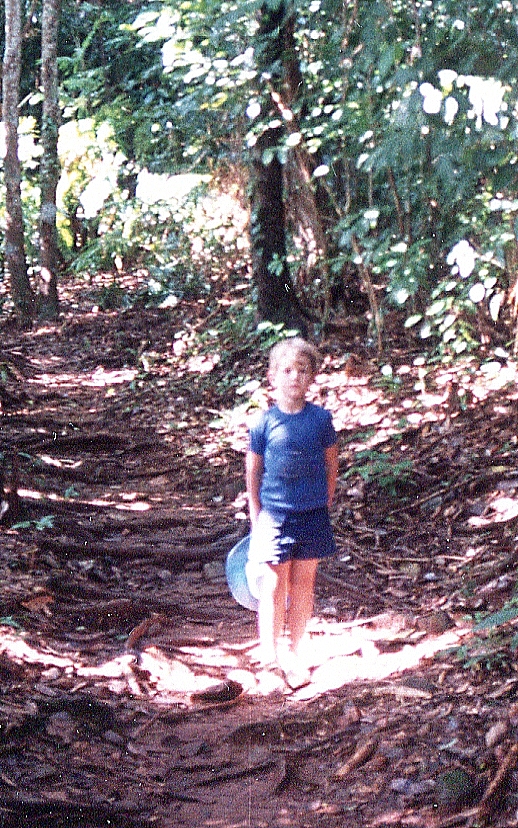
We did not go on, even though the track did, as it was nearing that time of day when the kids expected payment, ice-creams, for their arduous walks. So we retraced our steps.
As we walked along the beach, we could see a sleek fibreglass speedboat taking out obvious water skiing novices. An interesting innovation was a poll which could be made to protrude about 3 m outside of the boat, at 90° to the direction of travel. This is illustrated below.

This is used to instruct beginners before allowing them the freedom of a rope.
After ice creams for the kids and beer for me and Jacqui, the kids swam in the clearish water. Jacqui and I spoke to Anne-Marie and John, the American backpackers we had met on the water taxi. They had been in Australia for three weeks. Interestingly, they had spent five days in Singleton and understood completely when I told the story of the fast-talking bloke from Maitland and the Swedish tourists that we had camped next to in Kakadu National Park.
As we stood on the beach and talked, a landing barge arrived. A low loader was used to removed three collex bins and then replace after them retrieving the pallet of goods they required for the resort.
The trip back at 5 PM was like the outbound journey, except that we were the only ones on board the water taxi. Rohan was terrified and clung tightly in a foetal position to Jacqui. Upon arriving back at the shore, he told us in no uncertain terms that he never wished to go on a boat like that again (Georgie and Owie’s excepted!).
Links to other posts
In the beginning: Motivation and Planning
NSW: Merry Beach, Bournda State Recreation Area
Victoria Pt 1: Mallacoota - Lakes Entrance, Lakes Entrance - Melbourne
Tasmania: 1st - 18th February, 19th - 27th February
Victoria Pt 2: 28th February - 12th March
South Australia: 13th March - 27th March
Western Australia Pt 1: 28th March - 17th April
Western Australia Pt 2: 18th April - 5th May
Northern Territory: 6th May - 17th May
Queensland Pt1: 18th May - 31st May
Queensland Pt 2 to Sydney: 1st June - 20th June